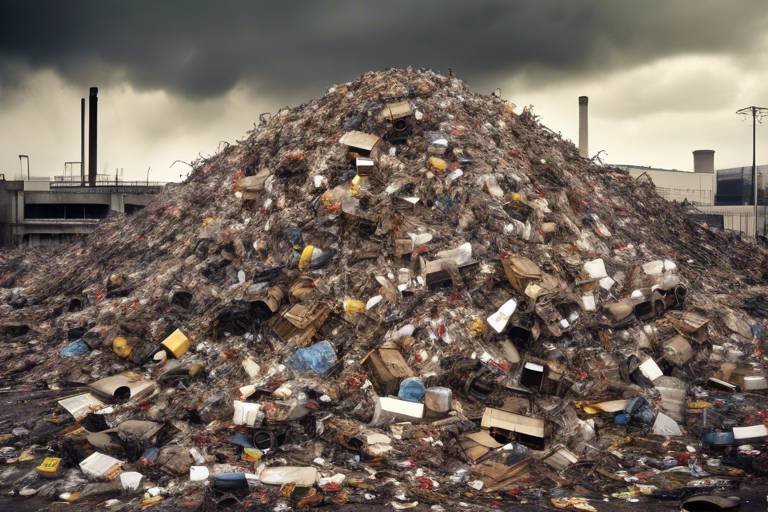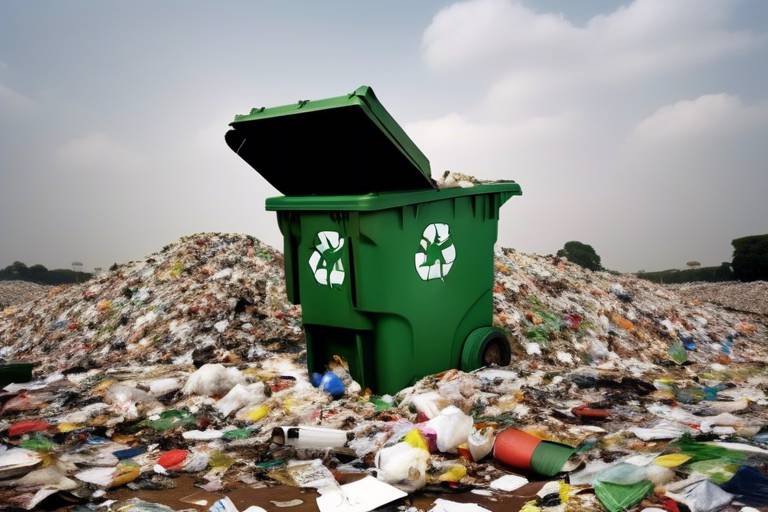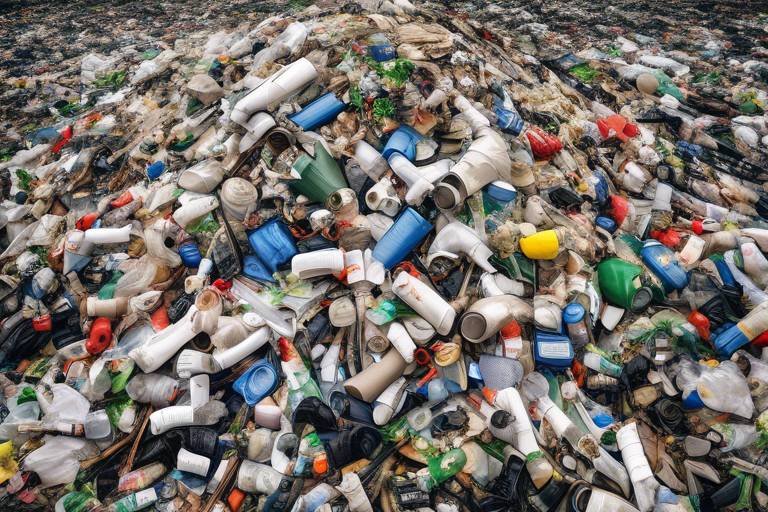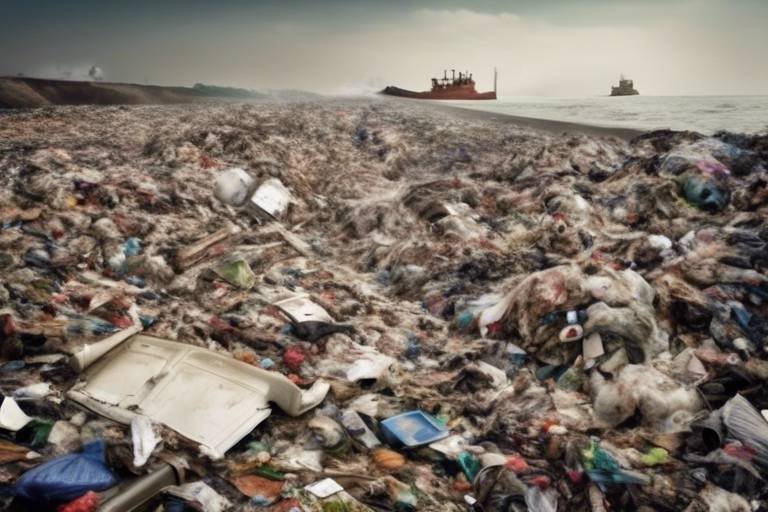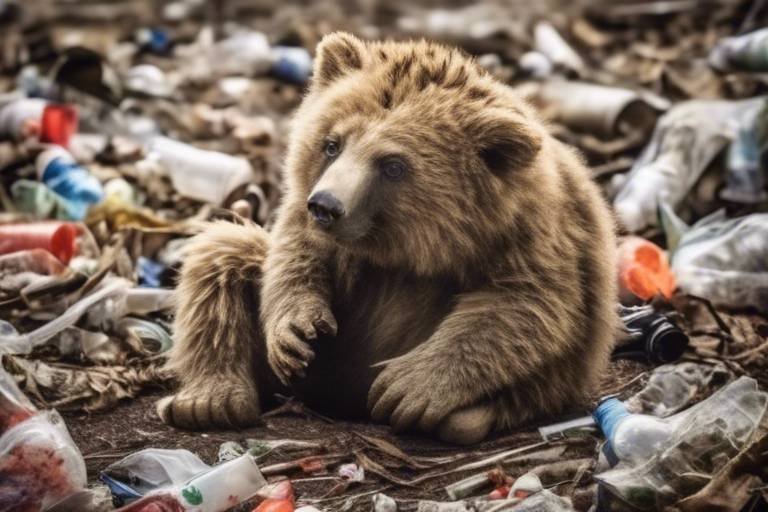What is Industrial Waste Management?
Industrial waste management is a critical aspect of ensuring that industries operate sustainably while minimizing their environmental footprint. In essence, it involves the systematic control of waste generated from industrial activities, which can range from manufacturing processes to construction and beyond. The goal is to manage waste in a way that not only complies with legal regulations but also promotes environmental sustainability and public health.
Imagine a bustling factory floor where machines hum and products are created. For every item produced, there’s a byproduct—some of which may be hazardous or non-biodegradable. This is where industrial waste management steps in, acting like a safety net that catches all the unwanted remnants of production. Effective waste management strategies help in sorting, recycling, and disposing of waste responsibly, ensuring that harmful substances don't end up contaminating our air, water, or soil.
Moreover, industrial waste management is not just about disposal; it’s about resource recovery and pollution prevention. By reclaiming valuable materials from waste, industries can reduce their reliance on virgin resources, which is crucial in today’s resource-constrained world. For instance, metals, plastics, and even chemicals can often be recovered and reused, turning waste into a resource rather than a burden.
In many ways, effective industrial waste management is like a well-oiled machine, where each component works together to minimize waste and maximize efficiency. It encompasses various methods, including recycling, treatment, and safe disposal, tailored to the specific types of waste generated by different industries. The importance of this management system cannot be overstated, as it plays a vital role in protecting our environment and ensuring compliance with local and international regulations.
As we delve deeper into the intricacies of industrial waste management, we will explore the types of industrial waste, their environmental impacts, and the best practices that industries can implement to create a more sustainable future. In doing so, we not only safeguard our planet but also pave the way for innovation and efficiency in industrial operations.

Understanding Industrial Waste
Industrial waste is a term that encompasses a wide range of materials generated during various industrial processes. This waste can come from manufacturing, construction, mining, and other sectors, and it often varies significantly in composition and impact. Understanding the different types of industrial waste is crucial for developing effective management strategies. From hazardous materials to non-hazardous byproducts, the nature of this waste can pose serious challenges if not handled properly.
There are generally two main categories of industrial waste: hazardous waste and non-hazardous waste. Hazardous waste includes substances that are flammable, toxic, or reactive, posing significant risks to human health and the environment. Examples include chemicals, heavy metals, and certain types of batteries. On the other hand, non-hazardous waste, while less dangerous, can still contribute to environmental issues if not managed correctly. This category often includes materials like packaging, scrap metal, and construction debris.
The environmental impacts of industrial waste can be profound. Improper disposal can lead to soil contamination, water pollution, and air quality degradation. For instance, when hazardous waste is dumped into landfills, it can leach into groundwater, affecting drinking water sources and harming aquatic ecosystems. Similarly, emissions from industrial processes can release harmful pollutants into the air, contributing to respiratory issues and climate change.
To illustrate the potential environmental impacts, consider the following table that outlines common types of industrial waste and their associated risks:
| Type of Waste | Examples | Environmental Impact |
|---|---|---|
| Hazardous Waste | Chemicals, Heavy metals, Batteries | Soil and water contamination, Air pollution |
| Non-Hazardous Waste | Packaging, Scrap metal, Construction debris | Landfill overflow, Resource depletion |
The need for effective industrial waste management is more critical than ever. As industries continue to grow, the volume of waste generated also increases, making it essential to implement robust management strategies that not only comply with regulations but also promote sustainability. By understanding the various types of industrial waste and their impacts, companies can take proactive steps to mitigate risks and enhance their operational efficiency.
In conclusion, a comprehensive understanding of industrial waste is essential for any business involved in manufacturing or other industrial activities. By recognizing the types of waste produced and their potential environmental impacts, industries can develop effective waste management strategies that contribute to a cleaner and safer environment.

Importance of Waste Management
Effective waste management is not just a regulatory requirement; it is a critical component of sustainable industrial practices. By managing waste properly, industries can significantly minimize their environmental impact, which is essential in today's world where climate change and pollution are pressing concerns. Imagine a world where factories operate without considering their waste; it would be akin to a ship sailing without a compass, heading straight for disaster.
One of the primary benefits of proper waste disposal is pollution reduction. When waste is not managed effectively, it can lead to the contamination of air, water, and soil, causing harm to both the environment and human health. For instance, toxic chemicals released into the air can affect respiratory health, while waste dumped into water bodies can disrupt aquatic ecosystems. By implementing effective waste management strategies, industries can play a crucial role in protecting natural resources and public health.
Moreover, waste management contributes to resource conservation. Many industrial processes generate materials that can be recycled or repurposed. By reclaiming these materials, industries not only reduce the volume of waste sent to landfills but also conserve valuable resources. This can lead to significant cost savings in the long run. For example, recycling metals can save up to 95% of the energy required to produce new metal from raw materials. This is not just a win for the environment; it's a win for business.
Compliance with regulations is another vital aspect of waste management. Governments around the world have established strict guidelines to ensure that industries handle their waste responsibly. Failure to comply with these regulations can result in hefty fines and damage to a company's reputation. Therefore, effective waste management practices are essential for maintaining compliance and avoiding legal issues.
In summary, the importance of waste management cannot be overstated. It encompasses several key benefits:
- Pollution Reduction: Minimizing harmful emissions and discharges.
- Resource Conservation: Saving materials and energy through recycling.
- Regulatory Compliance: Adhering to laws to avoid penalties.
- Enhanced Corporate Image: Building a reputation as a responsible business.
As industries strive for sustainability, the emphasis on waste management will only continue to grow. Companies that prioritize effective waste management not only contribute to a healthier planet but also position themselves as leaders in their respective fields. It's a win-win scenario that benefits everyone.

Environmental Impact
Industrial waste is not just a byproduct of manufacturing; it poses significant threats to our environment if not managed properly. When we think about waste, we often picture cluttered landfills and overflowing garbage bins, but the reality of industrial waste goes far beyond that. It can seep into our waterways, pollute our air, and contaminate our soil, leading to dire consequences for both ecosystems and human health. Imagine a river once teeming with life, now reduced to a toxic stream due to careless waste disposal practices. This transformation is not just an environmental tragedy; it’s a wake-up call for industries to adopt more responsible waste management practices.
The effects of improper industrial waste disposal can be categorized into several key areas:
- Air Quality: Emissions from industrial waste can release harmful pollutants into the atmosphere, contributing to respiratory issues and other health problems. Volatile organic compounds (VOCs), for instance, can lead to smog formation and acid rain.
- Water Quality: Contaminants from industrial waste can leach into groundwater and surface water, affecting drinking water sources and aquatic ecosystems. Heavy metals and chemicals can bioaccumulate in fish and other organisms, posing risks to wildlife and humans alike.
- Soil Contamination: When waste is improperly disposed of on land, it can lead to soil degradation. This not only affects agricultural productivity but also disrupts local flora and fauna, leading to a loss of biodiversity.
Moreover, the long-term consequences of these impacts can be staggering. Ecosystems take years, if not decades, to recover from pollution. The loss of biodiversity can destabilize entire food chains, while communities living near contaminated sites often face health crises and economic hardships. The stark reality is that industrial waste management is not just a regulatory obligation; it is a moral imperative to protect our planet and future generations.
In response to these challenges, industries are increasingly recognizing the need for sustainable waste management practices. By implementing responsible disposal methods and investing in innovative technologies, companies can significantly reduce their environmental footprint. This proactive approach not only helps mitigate pollution but also enhances their public image and compliance with regulatory requirements.
To illustrate the importance of effective waste management, consider the following table that outlines the potential environmental impacts of various types of industrial waste:
| Type of Waste | Potential Environmental Impact |
|---|---|
| Chemical Waste | Water contamination and air pollution |
| Plastic Waste | Soil degradation and harm to wildlife |
| Metal Waste | Heavy metal accumulation in soil and water |
| Organic Waste | Greenhouse gas emissions and odor pollution |
In conclusion, the environmental impact of industrial waste is profound and far-reaching. It is crucial for industries to recognize their role in this issue and to take decisive action towards sustainable waste management practices. By doing so, they not only protect the environment but also contribute to a healthier future for all.

Pollution Prevention
Pollution prevention is not just a buzzword; it’s a vital strategy that industries must adopt to protect our planet. Imagine a world where factories operate without spewing harmful waste into the air, water, or soil. Sounds like a dream, right? But this dream can become a reality through effective pollution prevention practices. By focusing on reducing waste at its source, industries can significantly lessen their environmental impact while also cutting costs. It’s a win-win situation!
One of the most effective approaches to pollution prevention is the implementation of cleaner production techniques. This involves modifying production processes to reduce waste generation and minimize the use of hazardous materials. For instance, industries can switch to less toxic raw materials or redesign processes to be more efficient. This not only decreases the amount of waste produced but also enhances product quality.
Another critical aspect of pollution prevention is employee training and engagement. When workers are educated about the environmental impacts of their actions, they are more likely to adopt sustainable practices. A well-informed workforce can identify areas for improvement and suggest innovative solutions that contribute to pollution reduction. For example, a simple change in how materials are handled can lead to significant waste reductions. Companies can encourage this by creating a culture of sustainability, where everyone feels responsible for minimizing pollution.
Moreover, industries can utilize technology to monitor and manage their waste more effectively. Advanced software solutions can track waste generation in real-time, helping companies identify trends and areas for improvement. By analyzing this data, industries can implement targeted strategies to reduce waste and enhance operational efficiency. For instance, a manufacturing plant might discover that certain processes are generating excess waste and could be modified to minimize this output.
To further illustrate the importance of pollution prevention, consider the following table that highlights some common pollution prevention strategies and their benefits:
| Pollution Prevention Strategy | Benefits |
|---|---|
| Cleaner Production Techniques | Reduces waste and hazardous materials, enhances product quality |
| Employee Training | Increases awareness, encourages sustainable practices |
| Technology Utilization | Real-time waste tracking, data-driven decision making |
| Process Modification | Improves efficiency, lowers costs, reduces waste generation |
In conclusion, pollution prevention is not just about compliance; it’s about creating a sustainable future. By adopting these practices, industries can play a pivotal role in safeguarding our environment for future generations. So, let’s take the plunge into pollution prevention and make a difference today!
- What is pollution prevention? Pollution prevention refers to strategies and practices that reduce or eliminate the creation of pollutants at their source.
- Why is pollution prevention important? It is crucial for protecting the environment, conserving resources, and ensuring compliance with environmental regulations.
- How can industries implement pollution prevention? Industries can adopt cleaner production techniques, train employees, utilize technology, and modify processes to reduce waste.
- What are some benefits of pollution prevention? Benefits include reduced waste generation, lower costs, improved product quality, and enhanced sustainability.

Resource Recovery
Resource recovery is an essential component of industrial waste management that focuses on reclaiming valuable materials from waste streams. In a world where resources are becoming increasingly scarce, the ability to recycle and recover materials not only conserves natural resources but also reduces the environmental impact of waste disposal. Think of it as a treasure hunt within your own waste; instead of discarding materials that could still be useful, industries can adopt practices that allow them to extract and repurpose these resources.
One of the primary benefits of resource recovery is its potential to transform waste into a valuable asset. For instance, metals, plastics, and paper can often be extracted from industrial waste and reprocessed for use in new products. This not only reduces the volume of waste sent to landfills but also minimizes the need for virgin materials, which can be energy-intensive to extract and process. The process of resource recovery can be broken down into a few key strategies:
- Recycling: This involves collecting and processing materials that would otherwise be thrown away as trash and turning them into new products. For example, scrap metal can be melted down and reformed into new metal products.
- Composting: Organic waste, such as food scraps and yard waste, can be composted to create nutrient-rich soil amendments. This not only diverts waste from landfills but also enriches the soil.
- Energy Recovery: Some waste materials can be converted into energy through processes such as incineration or anaerobic digestion. This not only reduces the amount of waste but also produces energy that can be utilized.
Implementing resource recovery practices can significantly enhance a company's sustainability profile. Not only does it demonstrate a commitment to environmental stewardship, but it can also lead to cost savings. By recovering materials, companies can reduce their purchasing costs for raw materials and lower their waste disposal fees. Additionally, regulatory bodies are increasingly incentivizing resource recovery practices through various programs and subsidies, making it a financially sound decision.
Moreover, the adoption of advanced technologies has made resource recovery more efficient and effective than ever before. Innovations such as automated sorting systems and chemical recycling processes allow industries to recover materials with higher purity levels and at a faster rate. As industries continue to evolve, embracing these technologies will be crucial for maximizing resource recovery potential.
In conclusion, resource recovery is not just a trend; it is a critical strategy for industries aiming to reduce their environmental footprint while also benefiting economically. By viewing waste as a resource rather than a problem, companies can contribute to a more sustainable future while simultaneously enhancing their operational efficiency. The journey toward effective resource recovery may require investment and commitment, but the rewards—both ecological and financial—are well worth the effort.
Q1: What is resource recovery?
Resource recovery refers to the process of reclaiming valuable materials from waste streams, allowing industries to recycle and repurpose materials that would otherwise be discarded.
Q2: Why is resource recovery important?
Resource recovery is important because it conserves natural resources, reduces waste sent to landfills, and can lead to significant cost savings for industries through reduced raw material purchases.
Q3: What are some common methods of resource recovery?
Common methods of resource recovery include recycling, composting, and energy recovery, each targeting different types of waste materials to maximize resource extraction.
Q4: How can technology improve resource recovery?
Advanced technologies, such as automated sorting systems and chemical recycling processes, enhance the efficiency and effectiveness of resource recovery by allowing for higher purity levels and faster processing.

Regulatory Framework
The landscape of industrial waste management is shaped significantly by a complex network of regulations and guidelines designed to protect the environment and public health. These regulations vary from country to country and even state to state, reflecting different environmental priorities and legal frameworks. Understanding this regulatory framework is essential for industries aiming to comply with laws while minimizing their environmental impact.
At the heart of these regulations are several key laws that govern how industrial waste should be handled. In the United States, for instance, the Resource Conservation and Recovery Act (RCRA) is a cornerstone legislation that provides the framework for managing hazardous and non-hazardous waste. This act outlines the responsibilities of waste generators, transporters, and disposal facilities, ensuring that waste is managed in a way that protects human health and the environment.
In addition to federal laws, many states have their own regulations that may impose stricter requirements. These state regulations can include specific guidelines on waste classification, treatment methods, and disposal practices. It’s crucial for industries to not only be aware of these federal regulations but also to keep abreast of state-specific laws that may impact their operations.
Moreover, international agreements, such as the Basel Convention, play a significant role in governing the transboundary movement of hazardous waste. This treaty aims to reduce the amount of hazardous waste generated and ensures that waste is disposed of in an environmentally sound manner. Industries engaged in international trade must be particularly vigilant about compliance with these regulations to avoid legal penalties and reputational damage.
To navigate this complex regulatory landscape effectively, industries often rely on a combination of internal compliance teams and external consultants. These professionals help ensure that waste management practices align with current laws and regulations, thereby reducing the risk of violations. Regular audits and training programs are also vital components of an effective compliance strategy, as they help keep employees informed about the latest regulatory changes.
In summary, the regulatory framework surrounding industrial waste management is multifaceted and requires diligent attention from industries. By adhering to these regulations, companies not only avoid legal repercussions but also contribute to the broader goal of environmental sustainability. The importance of compliance cannot be overstated; it serves as the backbone of responsible waste management practices.
- What is the primary purpose of industrial waste management regulations?
These regulations aim to protect human health and the environment by ensuring that waste is managed safely and responsibly. - How can industries stay compliant with waste management laws?
Industries can stay compliant by regularly reviewing regulations, conducting audits, and providing employee training on waste management practices. - What are the consequences of non-compliance?
Non-compliance can lead to legal penalties, fines, and damage to a company's reputation, alongside potential environmental harm. - Are there international regulations for industrial waste?
Yes, agreements like the Basel Convention govern the international movement of hazardous waste and promote environmentally sound disposal practices.

Best Practices in Waste Management
When it comes to industrial waste management, adopting best practices is not just a matter of compliance; it's a pathway to greater efficiency and sustainability. By implementing effective strategies, industries can not only minimize their waste output but also enhance their overall operational performance. The key to successful waste management lies in understanding the various methods available and tailoring them to fit specific industrial needs.
One of the most effective strategies is waste minimization. This approach focuses on reducing waste at its source, which is far more efficient than dealing with it after it has been generated. For instance, industries can conduct thorough assessments of their processes to identify areas where waste can be reduced. This might involve altering production methods, optimizing resource use, or even changing the materials used in manufacturing. By making these adjustments, companies can not only lower their waste generation but also save on costs associated with disposal and treatment.
Another essential practice is the adoption of innovative technologies that facilitate better waste management. Emerging technologies such as smart sensors, data analytics, and automation can significantly enhance waste tracking and management processes. For example, smart sensors can monitor waste levels in real-time, allowing industries to adjust their operations dynamically and reduce excess waste. Data analytics can provide insights into waste generation patterns, enabling companies to make informed decisions about resource allocation and waste reduction strategies.
Moreover, employee training and engagement play a critical role in successful waste management. When workers are educated about the importance of waste reduction and are actively involved in the process, they are more likely to adopt sustainable practices. Regular training sessions, workshops, and incentives can motivate employees to contribute to waste management efforts. This collective commitment not only fosters a culture of sustainability but also leads to innovative ideas for reducing waste.
Lastly, establishing partnerships with waste management service providers can enhance an industry's ability to handle waste effectively. These partnerships can offer valuable expertise in recycling, resource recovery, and disposal methods. By collaborating with specialized organizations, industries can leverage advanced technologies and best practices that they may not have the resources to implement independently.
To summarize, the best practices in waste management encompass a holistic approach that integrates waste minimization, innovative technologies, employee engagement, and strategic partnerships. By focusing on these areas, industries can significantly improve their waste management processes, leading to not only environmental benefits but also economic gains. As we move forward, it's essential for industries to continuously evaluate and adapt their waste management strategies to align with evolving regulations and sustainability goals.
- What is waste minimization? Waste minimization refers to strategies aimed at reducing the amount of waste generated at the source, rather than managing it after it has been created.
- How can technology help in waste management? Technologies like smart sensors and data analytics can improve waste tracking and management processes, leading to more efficient operations.
- Why is employee training important in waste management? Educating employees about waste reduction encourages them to adopt sustainable practices, fostering a culture of sustainability within the organization.
- What role do partnerships play in waste management? Collaborating with waste management service providers allows industries to access expertise and advanced technologies, enhancing their waste management capabilities.

Waste Minimization Techniques
Waste minimization is not just a buzzword; it’s a crucial strategy that industries must adopt to ensure sustainable operations. At its core, waste minimization involves reducing the amount of waste generated at the source, which can lead to significant cost savings and a smaller environmental footprint. Imagine a factory that produces widgets. If it can find ways to use less raw material and produce fewer defective items, it not only saves money but also reduces the waste it sends to landfills. This proactive approach is essential in today’s world where resources are finite and environmental concerns are mounting.
One effective technique is process optimization. This involves reviewing and refining manufacturing processes to eliminate inefficiencies. For instance, by utilizing advanced machinery that operates with higher precision, industries can reduce material waste. Additionally, implementing lean manufacturing principles can streamline operations, ensuring that every step in the production process adds value and minimizes excess.
Another powerful method is employee training and engagement. When workers are educated about the importance of waste reduction and are actively involved in the process, they can identify wasteful practices and suggest improvements. For example, if employees are trained to recognize defective products early in the production line, they can prevent waste from accumulating. This not only increases efficiency but also fosters a culture of sustainability within the organization.
Moreover, industries can adopt substitution techniques, which involve replacing hazardous materials with less harmful alternatives. By doing so, not only do companies minimize waste, but they also reduce the risks associated with handling dangerous substances. For instance, a manufacturer might switch from using solvents in their cleaning processes to water-based solutions, significantly cutting down on hazardous waste production.
To further illustrate these techniques, consider the following table that summarizes some common waste minimization strategies:
| Technique | Description | Benefits |
|---|---|---|
| Process Optimization | Refining manufacturing processes to eliminate inefficiencies. | Cost savings, reduced material waste. |
| Employee Training | Educating employees about waste reduction practices. | Increased efficiency, culture of sustainability. |
| Substitution Techniques | Replacing hazardous materials with safer alternatives. | Reduced hazardous waste, improved safety. |
Lastly, implementing recycling and recovery programs can significantly contribute to waste minimization. By establishing systems to recycle materials within the production process, industries can reclaim valuable resources that would otherwise be discarded. For example, scrap metal from a manufacturing process can be melted down and reused, creating a closed-loop system that not only conserves resources but also reduces the overall waste generated.
In conclusion, waste minimization techniques are essential for industries aiming to enhance sustainability and efficiency. By optimizing processes, engaging employees, substituting materials, and implementing recycling programs, companies can make a substantial impact on their waste generation. The journey towards minimizing waste is not only beneficial for the environment but also for the bottom line, proving that sustainability and profitability can go hand in hand.
- What is waste minimization? Waste minimization refers to the strategies and practices that reduce the amount of waste generated at the source.
- Why is waste minimization important? It helps in conserving resources, reducing pollution, and saving costs associated with waste disposal.
- How can employees contribute to waste minimization? By being trained to recognize wasteful practices and suggesting improvements, employees play a crucial role in minimizing waste.
- What are some common waste minimization techniques? Common techniques include process optimization, employee training, and recycling programs.

Innovative Technologies
In the ever-evolving landscape of industrial waste management, are becoming the cornerstone of effective waste handling and sustainability. These technologies not only help in managing waste but also in transforming it into valuable resources. Imagine a world where waste is not just discarded but reimagined; that's the power of innovation in waste management!
One of the standout technologies making waves in the industry is advanced waste treatment systems. These systems utilize cutting-edge methods such as bioremediation and pyrolysis to break down hazardous materials and convert them into safe, reusable products. For instance, pyrolysis thermally decomposes organic material in the absence of oxygen, producing bio-oil, gas, and char, which can be repurposed in various industries.
Another exciting development is the use of smart waste management systems. These systems integrate the Internet of Things (IoT) to monitor waste levels in real-time, optimizing collection routes and schedules. This not only reduces operational costs but also minimizes the carbon footprint associated with waste transport. Imagine waste trucks that know exactly when to pick up waste, reducing unnecessary trips and emissions!
Moreover, the implementation of AI-powered analytics is revolutionizing how industries approach waste management. By analyzing data from various sources, AI can predict waste generation trends, enabling businesses to adjust their production processes accordingly. This proactive approach not only minimizes waste but also enhances operational efficiency.
To illustrate the impact of these technologies, consider the following table that highlights some key innovative solutions in industrial waste management:
| Technology | Description | Benefits |
|---|---|---|
| Advanced Waste Treatment Systems | Utilizes methods like bioremediation and pyrolysis. | Transforms hazardous waste into reusable resources. |
| Smart Waste Management Systems | IoT-enabled systems for real-time waste monitoring. | Optimizes collection routes, reducing costs and emissions. |
| AI-Powered Analytics | Data analysis to predict waste generation trends. | Enhances efficiency and minimizes waste production. |
In addition to these technologies, renewable energy solutions are also gaining traction. Industries are increasingly turning to waste-to-energy plants that convert waste materials into energy through combustion or anaerobic digestion. This not only helps in waste reduction but also provides a sustainable energy source, closing the loop on resource utilization.
As we embrace these innovative technologies, it's crucial to remember that their successful implementation relies on collaboration among stakeholders, including government bodies, industries, and the community. By working together, we can create a robust framework that supports sustainability and environmental stewardship.
- What are the main benefits of innovative technologies in waste management? They enhance efficiency, reduce environmental impact, and help in resource recovery.
- How does smart waste management work? It uses IoT to monitor waste levels and optimize collection processes in real-time.
- Can AI really help in waste management? Yes, AI can analyze data to predict waste trends and improve operational processes.
Frequently Asked Questions
- What is industrial waste?
Industrial waste refers to any waste produced during industrial activities. This includes materials discarded from manufacturing processes, chemical production, and construction. It's essential to manage this waste properly to prevent environmental harm.
- Why is industrial waste management important?
Effective industrial waste management is crucial for minimizing pollution and conserving resources. It helps in reducing the environmental footprint of industries, ensuring compliance with regulations, and promoting sustainability in operations.
- What are the types of industrial waste?
Industrial waste can be categorized into several types, including hazardous waste, non-hazardous waste, recyclable materials, and organic waste. Each type requires specific management strategies to mitigate its environmental impact.
- How does improper waste disposal affect the environment?
Improper disposal of industrial waste can lead to severe environmental consequences, such as soil contamination, water pollution, and air quality degradation. These impacts can harm wildlife, ecosystems, and human health.
- What are some best practices for waste management?
Best practices include implementing waste minimization techniques, recycling and resource recovery, and adopting innovative technologies. These strategies not only enhance operational efficiency but also contribute to a more sustainable environment.
- What regulations govern industrial waste management?
Various regulations, such as the Resource Conservation and Recovery Act (RCRA) in the U.S., outline the legal framework for managing industrial waste. Compliance with these regulations is vital for industries to avoid legal penalties and protect the environment.
- How can industries prevent pollution?
Industries can prevent pollution by adopting practices such as reducing waste at the source, using less harmful materials, and implementing effective waste treatment technologies. These measures are essential for minimizing environmental impact.
- What is resource recovery?
Resource recovery involves reclaiming valuable materials from waste to be reused or recycled. This process not only conserves natural resources but also reduces the volume of waste sent to landfills, promoting sustainability.
- What innovative technologies are available for waste management?
Emerging technologies such as waste-to-energy systems, advanced recycling methods, and smart waste tracking solutions are revolutionizing waste management. These innovations help industries manage waste more effectively and sustainably.

